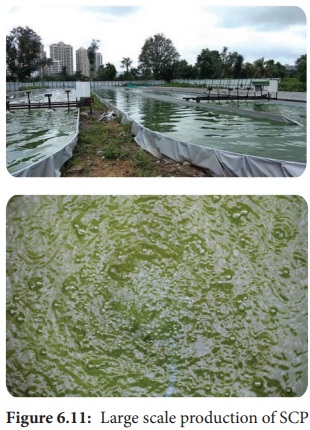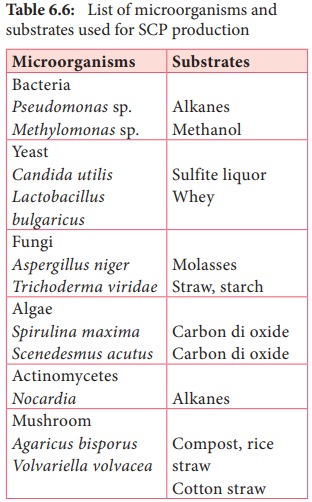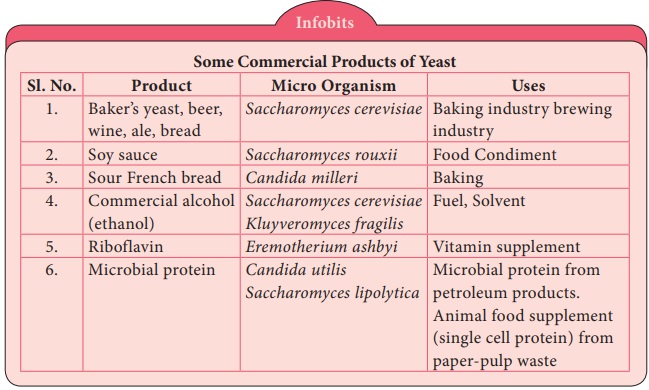Industrial Microbiology - Industrial Production of Single Cell Protein | 12th Microbiology : Chapter 6 : Industrial Microbiology
Chapter: 12th Microbiology : Chapter 6 : Industrial Microbiology
Industrial Production of Single Cell Protein
Industrial Production of Single Cell Protein
Single
cell protein refers to the microbial cells or total protein extracted from pure
microbial cell culture (monoculture) which can be used as protein supplement
for humans or animals. During ancient times, the tribes in the Central African
Republic used a spiral shaped Cyanobacterium named Spirulina platensis as food. They collected it as mats from the bottom of seasonally dried up ponds and shallow
waters around Lake Chad and dried them in the sun and made small cakes called
“Dihe”.
Infobits
Zymology:
Zymology also known as “Zymurgy” (from the Greek–means, the
workings of fermentation) is an applied science which studies the biochemical
process of fermentation and its practical uses. It includes selection of
fermenting yeast and bacteria, species and their use in brewing, wine making,
fermenting milk and other fermented foods. The wine yeast Zymurgist one who
studies or practices zymurgy; a knowledgeable brewer.
During
the World war II, when there were shortage in proteins and vitamins in the
diet, the Germans produced yeasts and a mould named Geotrichum candidum was used as food.
The term Single Cell Protein was coined by C.L
Wilson (1966) at Massachusetts Institute of Technology (MIT), to represent the
cells of algae, bacteria, yeasts and fungi, grown for their protein contents.
The name was introduced by Prof. Scrimshow of MIT in 1967. The organisms like
Pseudomonas facilis, P. flava, Chlorella, Anabaena, Spirulina, Chlamydomonas,
and Agaricus are commonly used for SCP production. Large scale production of
SCP is shown in the Figure 6.11.

There are
several methods available for SCP production. In the Japanese method, flat tray
is used with artificial sunlight algae are cultivated in shallow ponds with
mechanical stirrers or in deeper ponds (not more than 20–30 cm deep) with
circulation pumps. Optimum, light is an important parameter for maximum growth
of SCP. Scenedesmus sp. grows 20
times faster in optimum light than in natural conditions. Optimum temperature
and optimum pH is varied according to the strain and intensity of light.
Example: Spirulina is cultivated at
25–35ºC with pH 9.5. Table 6.6 shows
different types of microorganisms and substrates used for SCP production.

SCP Steps involved in SCP production
Provision of carbon source with added nitrogen, CO2, ammonia,
trace minerals for growth
↓
Prevention of contamination by using sterilized medium and
fermentation equipments
↓
Selected microorganism is inoculated in a pure form
↓
Adequate aeration and cooling is provided
↓
Microbial
biomass is harvested and recovered by flocculation or centrifugation
flocculants
↓
Harvested algae are dewatered anddried on open sand beds
↓
Processing biomass and enhancing it for use and storage
Advantages of using microorganisms for SCP production:
1. Microorganisms grow at a very rapid rate under
optimal culture conditions.
2. The quality and quantity of protein
content in microorganisms is better compared to higher plants and animals.
3. A wide range of raw materials which are
otherwise wasted, can be fruitfully used for SCP production
4. The culture conditions and the fermentation
processes are very simple.
5. Microorganisms can be easily handled and subjected to genetic manipulations
Pruteen was the 1st commercial SCP used as animal
feed additive with 72% of protein. Pruteen was produced from bacteria named
Methylophilus mehylotrophus cultured on methanol.
In India, National Botanical Research Institute (NBRI) and the
Central Food Technological Research Institute (CFTRI) are involved in the
production of SCP.
In CPFTRI, SCP is produced from algae cultured on sewage
During
the cultivation of SCP, care must be taken to prevent and control the
contamination by other micro organisms, which produce mycoxins or cyanotoxins.
This is controlled by using the fungus Scytaliclium
acidophilum which grows at a low
PH. It allows the hydrolysation of paper wastes to a sugar medium and also
creates aseptic condition at low cost.

Related Topics